AudioReputation is reader-supported. When you buy through links on our site, we may earn an affiliate commission Learn More
Do you want to learn more about various types of audio connectors and adapters? You’ve come to the right place! We will list and explain to you the most common types of connectors you come across every day. But we won’t stop there. We’ll also help you learn how to make a difference between various terms you see when searching for an audio connector or an adapter. Therefore, you should definitely keep reading!
Table of Contents
Major Types of Audio Connectors and Adapters
There are many different types of audio connectors and adapters available, including:
- 3.5mm audio jack
- RCA connector
- XLR connector
- 1/4 inch (6.35mm) jack
- USB audio
- HDMI
- Optical (TOSLINK)
- Bluetooth
- DIN connectors
- Speaker wire
The Basic Terms a Lot of People Struggle With
Before we begin explaining the actual types of audio connectors and adapters, we think it’s important that we first cover all of the basics. So, let’s start with the most common questions users have.
Jacks vs. Plugs vs. Connectors – What’s the Difference?
We’re not planning on making this part any more confusing. So, we’ll put it simply: a plug is what you put into the port that’s designed for that plug. A jack is that port. Thus, a jack is a hole where the plug goes.
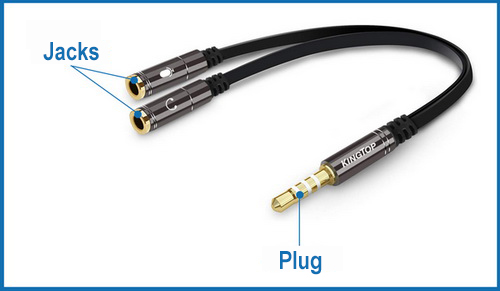
A connector is the end of a jack or a plug. The connector is what makes the various types of “jacks” and “plugs” different from each other.
What about Female and Male Connectors?
You’ve certainly heard of female and male connectors. Well, the male connector is the plug that we were explaining to you a moment ago. The female connector is the hole where you place a male connector. You can also call it the jack.

Mono vs. Stereo Audio Signal – What’s the Difference?
The main difference between these two is the number of channels they use. As the name states, a mono signal uses only one channel of audio. No matter how many speakers the audio goes through, they will reproduce the same copy of a signal. On the other hand, the stereo one uses two channels – left and right, which will create a more natural feel, which is not a surprise when you think about it. After all, we hear the sound with two ears, and our ears are basically two channels. Some users even say that stereo signal gives “space” to the sound.
Balanced vs. Unbalanced Audio Signal
An unbalanced signal means that the audio is passed on within two wires, which are a signal and a ground wire. They tend to pick up on the external noise which is why people use them for devices with short distances from each other.
On the contrary, the balanced audio has a ground wire and a hot and cold signal wire which balance each other out. They are much better at canceling out any external noise. Many experts also consider them to be a more durable option.
Types of Audio Connectors and Adapters
We’re getting to the part you’re here for! Now you have all of the info to fully understand the most common types of connectors and adapters and the difference between them.
The Phone Connector
Did you know that the 6.3 mm port used to be the ultimate connector for patching the old phones together? That is why people also know it as a phone connector. Today, this connector is used for musical instruments. Because of that, a lot of people also call it the guitar jack. It has a plug that is a quarter-inch or 6.3 millimeters wide, and an insulating ring, which is that black circle you see on the silver plug. Its connection is monophonic, a single-channel one. Besides instruments, you will also be able to find them on consoles, amplifiers, and some speakers.
Recommended Reading :
- How to Connect Surround Sound to TV Without HDMI?
- How to Connect Speakers to TV Without Receiver?
- How to Connect a Soundbar to TV with an Optical Cable?
A subtype of this connector is the 6.3 mm balanced connector or a quarter-inch balanced jack. It looks pretty similar to the regular 6.3 mm one. However, the balanced connector can pass on two channels of the audio signal – left and right. One channel is transmitted via the ring, and another one is passed on by the tip. You can find it on headphones, guitar amplifiers, keyboards, and even pianos.
The Headphone Jack
This one probably comes to your mind first when you think about audio connectors. It used to be the most popular type of connectors for headphones. Nowadays, if your headphones are not wireless, chances are, they use this plug to connect to other devices. Moreover, a lot of speakers also use it. Most desktops and laptops have a 3.5 mm port, so you can always choose an audio gadget with this connector without the fear that you might not be able to connect it to your computer. Experts also call it a stereo minijack, a 1/8-inch connector, or a 3.5 mm jack.
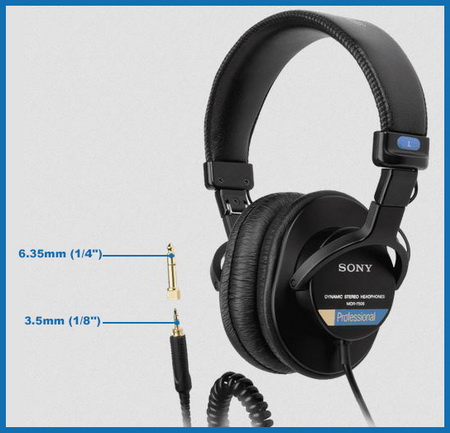
It’s similar to the 6.3 mm one, but the main difference, besides the width of the jack, is that it can have more than one black circle on the port. That means that it can carry more than one signal. Some jacks can even transmit three signals at the same time! In case your jack has two black rings, it can transmit both stereo audio and video.
The RCA Phono Connector
We’re certain that you’ve seen the RCA connector many times, especially if you have a home stereo. It is great for high-fidelity devices such as advanced audio equipment and DJ mixers. Moreover, you can see it on consoles, recorders, and amplifiers. Many know it as a phono plug. That’s because when they were designed in the 1940s, they were used for connecting phonographs to amplifiers. It has an unbalanced, mono connection. The Phono Connector comes with a pin that sticks out of the rest of the connector. In most cases, it will have two channels that are marked in red and white (or red and black) colors.

The Optical Connector
The optical connector was invented by Toshiba, and it was called the TOSLINK connector. It has a small plug that has the ability to transmit optical digital signals. You connect it to the port located on your device, which sends out red light. It transmits the signal through an optical fiber cable, and its range is around 5 meters or 15 feet. Experts believe it’s outdated since its range is pretty small, and many connectors today can transmit a signal of a much higher quality. Still, you can find the port for the TOSLINK connector on most receivers and central processing units.
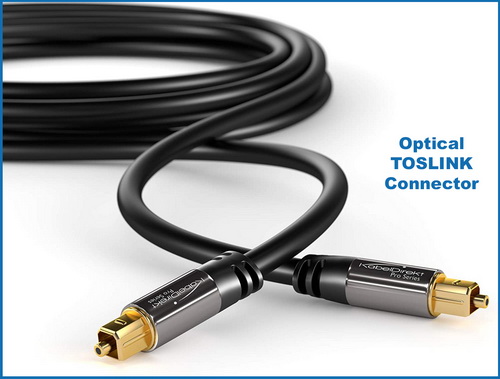
The XLR Connector
Even though it comes in many forms, the most common XLR connector is the one with three pins or holes, depending on whether it’s a female or a male connector. This jack is used for professional audio devices, mixers, microphones, audio interfaces, and amplifiers. It transmits a balanced audio signal. As a result, it has great protection against electromagnetic interference. That is the main reason why many manufacturers use it for their pro equipment. The XLR connector can also come with up to seven pins or sockets. Its name came from the revisions of the original connector. While we’re on that topic, Cannon Electronics produced the first XLR connector, as well as its revisions.
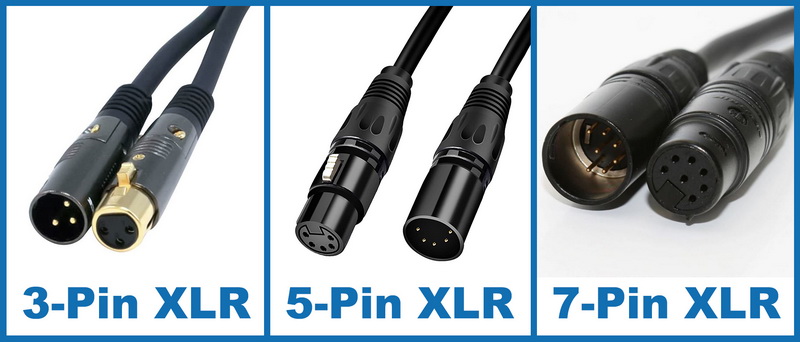
The Banana Connector
Banana plugs are single-wire connectors people mainly use to join wires of devices. They are usually 4 mm wide, although the 2 mm types are also common. Users connect them to speakers, amplifiers, and other types of audio equipment. They come with a metal pin that sticks out in the middle, which looks like a banana, and metal bulges that resemble leaves.
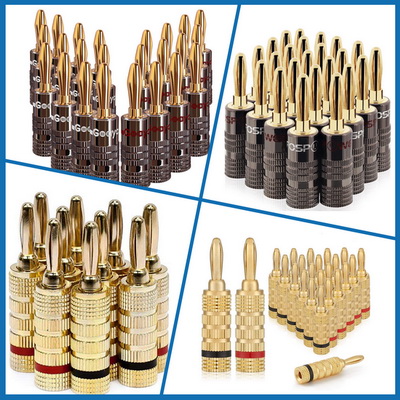
Banana plugs
The SpeakON Connector
The speakON connector’s main purpose is to work as an improved banana plug. It’s produced by Neutrik. You can find them on high-end audio systems, and they connect amplifiers with loudspeakers. Besides Neutrik, other manufacturers are using this type of connector. But, since the Neutrik trademarked speakON, other companies call it a speaker twist connector. In most cases, male and female connectors are able to stick together with the help of a special twist-lock mechanism.
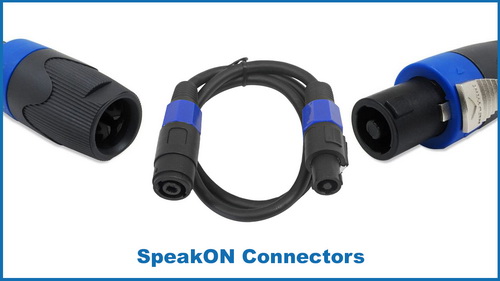
Frequently Asked Questions
As its name indicates, audio connectors are used to carry electronic auditory signals from one cable, wire, or device to another. They also help in providing users with grounding protection. There are several types of audio connectors, such as headphone jacks and optical connectors.
The five common audio ports are:
1. HDMI
2. TOSLINK
3. XLR
4. ¼”
5. Minijack
The most commonly used audio connector is the XLR cable. These connectors are easy to use because they click in place and don’t dislodge easily, and they also carry very balanced signals. Additionally, the sound that XLR cables carry is clean and bright, even if the cable is very long.
Final Thoughts
There you have it – a complete list of the most common types of audio connectors and adapters. We also made sure to include a thorough explanation of some regular terms related to this topic. Do you feel like an expert now?
If you have any questions, feel free to ask. Leave us a comment below, and we will reply promptly.
Since the time I got my first pair of headphones in 2012, I’ve been fascinated by these little gadgets that have the power to change our moods through our favorite music. Whether it was the cheap $5 earphones or the premium JBL headphones, I have played my favorite music on tons of different audio devices for all these years.
At AudioReputation, I test and review headphones of all kinds. From popular earbuds like the Airpods pro to the expensive HIFIMAN Susvara, I always perform a deep test and present my honest and unbiased opinion to my readers.

